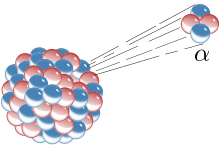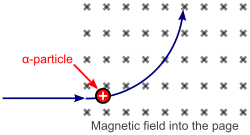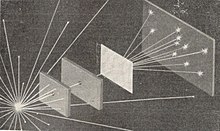Alpha particle
The alpha particles (α) are fully ionized nuclei, that is, without their corresponding electron envelope, of helium-4 (4He). These nuclei are made up of two protons and two neutrons. Lacking electrons, its electrical charge is positive (+2qe), while its mass is 4 amu.
They are usually generated in nuclear reactions or radioactive decay of other nuclides that are transmuted into lighter elements through the emission of said particles. Its penetration capacity is small; in the atmosphere they quickly lose their kinetic energy, because they strongly interact with other molecules due to their great mass and electric charge, generating a considerable amount of ions per centimeter of length traveled. In general, they cannot traverse thicknesses of several sheets of paper.
It has a load of 3,2⋅ ⋅ 10− − 19{displaystyle 3.2cdot 10^{-19} and a mass of 6,64⋅ ⋅ 10− − 27{displaystyle 6,64cdot 10^{-27}}kg.
Theoretical study of alpha decay led to the development of a quantum model, called the Gamow model. This model is based on a purely quantum effect known as the tunneling effect. Later, it was found that it could predict the half-lives of alpha-decayed nuclei, thus providing the first confirmation of the tunneling effect predicted by quantum mechanics.
In addition, the study of alpha radiation is interesting due to the various applications that this radiation presents. These include smoke detectors, antistatic devices, or thermoelectric generators, where alpha decay can be used as a power source. Another important application is the use of α-particle-emitting radionuclides to bombard tumors. Since they have a very small range, if they are thrown into the right area they can stop their growth, minimally affecting the surrounding areas.
Alpha particles have a net spin of zero. Due to the mechanism of their production in standard alpha radioactive decay, alpha particles generally have a kinetic energy of about 5 MeV and a speed close to 4% of the speed of light. They are a highly ionizing form of particulate radiation and, when they result from radioactive alpha decay, generally have a low penetration depth (stopped by a few centimeters of air or by skin).
However, the so-called long-range alpha particles from ternary fission are three times as energetic and three times as penetrating. The helium nuclei that make up 10-12% of cosmic rays are also often much higher in energy than those produced by nuclear decay processes, and therefore can be highly penetrating and able to pass through the human body and also many meters of dense solid armor, depending on its energy. To a lesser extent, this is also true for very high-energy helium nuclei produced by particle accelerators.
Name
Some scientific authors use "double ionized helium nuclei" (He2+
) and "alpha particles" as interchangeable terms. The nomenclature is not well defined, so not all high-speed helium nuclei are considered by all authors to be alpha particles. As with beta and gamma particles, the name used for the particle carries some slight connotations about its production process and its energy, but these are not rigorously applied.
Thus, alpha particles can be used loosely as a term when referring to the reactions of stellar helium nuclei (for example the alpha process), and even when they are produced as components of cosmic rays. A higher energy version of alphas produced in alpha decay is a common product of a rare result of nuclear fission called ternary fission. However, helium nuclei produced by particle accelerators such as cyclotrons, synchrotrons, and the like, are less likely to be called "alpha particles."
History of discovery and use

In the years 1899 and 1900, physicists Ernest Rutherford (working at McGill University in Montreal, Canada) and Paul Villard (working in Paris) separated ionizing radiation of nuclear origin into three types, based on the penetration of objects and in deflection by a magnetic field. These were named by Rutherford as: alpha, beta and gamma radiation. Alpha rays, made up of alpha particles, were defined by Rutherford as having the least penetration of ordinary objects; while gamma rays, of the same nature as X-rays, as the most penetrating.
Rutherford's work also included measurements of the relationship between the mass of an alpha particle and its charge, which led him to the hypothesis that alpha particles were doubly charged helium ions (later shown to be naked helium nuclei). In 1907, Ernest Rutherford and Thomas Royds finally demonstrated that alpha particles were indeed helium ions. They did this by allowing the alpha particles to penetrate a very thin glass wall of an evacuated tube, thus capturing a large number of the hypothetical helium ions inside the tube. They then caused an electrical spark inside the tube. The subsequent study of the spectra of the resulting gas showed that it was helium and that the alpha particles were indeed the hypothetical helium ions.
Since alpha particles occur naturally, but can be high enough in energy to participate in a nuclear reaction, their study led to much of the first insight into nuclear physics. Rutherford used the alpha particles emitted by radium bromide to infer that J. J. Thomson's plum pudding model of the atom was fundamentally wrong. In Rutherford's gold foil experiment, conducted by Rutherford's students Hans Geiger and Ernest Marsden, a narrow beam of alpha particles was established passing through very thin gold foil (a few hundred atoms thick). The alpha particles were detected by a zinc sulfide screen, which emits a flash of light when the alpha particles collide. Rutherford hypothesized that, assuming the "Plum pudding model|plum pudding]]" were correct, positively charged alpha particles would be deflected only slightly, if at all, by the predicted scattered positive charge.
Some of the alpha particles were found to be deflected by much larger angles than expected (at Rutherford's suggestion to check it) and some even bounced almost straight. Although most of the alpha particles passed straight through, as expected, Rutherford commented that the few particles that did miss were similar to shooting a 15-inch projectile at tissue paper to bounce it off, again assuming that the &# 34;plum pudding" was correct. The positive charge of the atom was determined to be concentrated in a small area at its center, making the positive charge dense enough to deflect any positively charged alpha particles that came near what was later called the nucleus.
Prior to this discovery, alpha particles were not known to be atomic nuclei themselves, nor were protons or neutrons known to exist. After this discovery, the 'plum pudding' model was abandoned; by J.J. Thomson, and Rutherford's experiment led to the Bohr model and later to the modern wave model of the atom.
.
.
In 1917, Rutherford went on to use alpha particles to accidentally produce what he later understood to be a directed nuclear transmutation of one element into another. The transmutation of elements from one to another had been understood since 1901 to be the result of natural radioactive decay, but when Rutherford projected alpha particles from alpha decay into the air, he discovered that this produced a new type of radiation that turned out to be hydrogen nuclei. (Rutherford called them protons.) Further experiments showed that the protons came from the nitrogen component of the air, and the reaction was deduced to be a transmutation of nitrogen into oxygen in the reaction
- 14N + α → 17O + p
To the adjacent images: According to the Bragg energy loss curve, it is recognizable that the alpha particle indeed loses more energy at the end of the trace.
Alpha particle sources
Alpha decay
The best-known source of alpha particles is the alpha decay of the heavier (>106 u atomic weight) atoms. When an atom emits an alpha particle in alpha decay, the mass number of the atom decreases by four due to the loss of all four nucleons from the alpha particle. The atomic number of the atom decreases by two, as a result of the loss of two protons - the atom becomes a new element. Examples of this type of nuclear transmutation by alpha decay are the decay of uranium into thorium, and that of radium into radon.
Alpha particles are commonly emitted by all of the largest radioactive nuclei, such as uranium, thorium, actinium, and radium, as well as the transuranium elements. Unlike other types of decay, alpha decay as a process must have an atomic nucleus of minimum size that can support it. The smallest nuclei found to date capable of emitting alpha are beryllium-8 and the lighter nuclides of tellurium (element 52), with mass numbers between 104 and 109. Alpha decay sometimes leaves the nucleus in an excited state; the emission of a gamma ray then removes the excess energy.
Mechanism of production of alpha decay
Unlike beta decay, the fundamental interactions responsible for alpha decay are a balance between the electromagnetic force and the nuclear force. Alpha decay is the result of Coulomb repulsion between the alpha particle and the rest of the nucleus, which both have a positive electrical charge, but which is held in check by the nuclear force. In classical physics, alpha particles do not have enough energy to escape the strong force potential well inside the nucleus (this well involves escaping the strong force to climb up the side of the well, which is followed by the electromagnetic force that causes a repulsive thrust to the other side).
However, the tunneling effect allows the alphas to escape even if they don't have enough energy to overcome the nuclear force. This is allowed by the wave nature of matter, which allows the alpha particle to spend part of its time in a region so far from the nucleus that the potential repulsive electromagnetic force has fully offset the attraction of the nuclear force. From this point, alpha particles can escape.
Ternary Fission
Especially energetic alpha particles derived from a nuclear process are produced in the relatively rare (one in hundreds) nuclear fission process of ternary fission. In this process, three charged particles are produced from the event instead of the normal two, with the smallest of the charged particles most likely (90% probability) being an alpha particle. Such alpha particles are called "long-range alpha" because, with their typical energy of 16 MeV, they are at an energy much higher than that produced in alpha decay. Ternary fission occurs both in neutron-induced fission (the nuclear reaction that occurs in a nuclear reactor), and when fissiles and actinide fissiles (i.e., heavy atoms capable of fission) undergo spontaneous fission as a form of radioactive decay.. In both induced and spontaneous fission, the higher energies available in heavy nuclei give rise to long-range alphas of higher energy than those from alpha decay.
Accelerators
Energetic helium nuclei (helium ions) can be produced by cyclotrons, synchrotrons, and other particle accelerators. The convention is that they are not usually called 'alpha particles'.
Reactions of the solar core
Helium nuclei can participate in nuclear reactions in stars, and have occasionally and historically been called alpha reactions (see, for example, the triple alpha process).
Cosmic Rays
In addition, extremely high-energy helium nuclei, sometimes called alpha particles, make up 10-12% of cosmic rays. The mechanisms of production of cosmic rays are still the subject of debate.
Energy and absorption
The energy of the alpha particle emitted in alpha decay is slightly dependent on the half-life of the emission process, with many-order-of-magnitude differences in half-life associated with energy changes of less than 50%, shown by the Geiger-Nuttall law.
The energy of the emitted alpha particles varies, with the highest energy alpha particles being those emitted by larger nuclei, but most alpha particles have energies between 3 and 7 MeV (mega-electron-volts), which they correspond to extremely long and extremely short half-lives of the alpha-emitting nuclides, respectively. The energies and ratios are often different and can be used to identify specific nuclides as in alpha spectrometry.
With a typical kinetic energy of 5 MeV; the speed of the emitted alpha particles is 15,000 km/s, which is 5% of the speed of light. This energy is a substantial amount of energy for a single particle, but their high mass makes alpha particles slower than any other common type of radiation, e.g. beta particles, neutron radiation.
Due to their charge and large mass, alpha particles are easily absorbed by materials, and can travel only a few centimeters in air. They can be absorbed by tissue paper or the outer layers of human skin. They usually penetrate the skin about 40 micrometers, which is equivalent to a few cells deep.
Biological effects
Due to the short absorption range and the inability to penetrate the outer layers of the skin, alpha particles are not, in general, dangerous to life unless the source is ingested or inhaled. Due to this high mass and strong absorption, if alpha-emitting radionuclides enter the body (by being inhaled, swallowed, or injected, as with the use of Thorotrast for high-quality X-ray imaging before the 1950s) alpha radiation is the most destructive form of ionizing radiation. It is the strongest ionizer and, with large enough doses, can cause any or all of the symptoms of radiation poisoning. Chromosome damage from alpha particles is estimated to be 10 to 1000 times greater than that caused by an equivalent amount of gamma or beta radiation, with an average set at 20 times. A study of European nuclear workers internally exposed to alpha radiation from plutonium and uranium found that when the relative biological efficacy is considered to be 20, the carcinogenic potential (in terms of lung cancer) of alpha radiation appears to be consistent with that reported. for doses of External gamma radiation, that is, a given dose of inhaled alpha particles, presents the same risk as a 20 times higher dose of gamma radiation. The powerful alpha emitter polonium 210 (one milligram of 210Po emits as many alpha particles per second as 4215 grams of 226Ra suspected Ra) plays a role in smoking-related lung cancer and bladder cancer. 210Po was used to kill Russian dissident and former FSB officer Alexander V. Litvinenko in 2006.
When alpha particle-emitting isotopes are ingested, they are much more dangerous than their half-life or decay rate suggests, due to the relatively high biological effectiveness of alpha radiation in causing biological damage. Alpha radiation is on average about 20 times more dangerous, and in experiments with inhaled alpha emitters up to 1,000 times more dangerous than equivalent activity from beta-emitting or gamma-emitting radioisotopes.
Anti-alpha particle
In 2011, members of the international STAR collaboration using the Heavy Ion Relativistic Accelerator at the US Department of Energy's Brookhaven National Laboratory detected the antimatter pair of helium nucleus, also known as antialpha.
The experiment used gold ions moving at nearly the speed of light colliding head-on to produce the antiparticle.
Applications
- Some smoke detectors contain a small amount of the alpha americ emitter-241. The alpha particles ionize the air into a small space. A small stream passes through that ionized air. Smoke particles from the fire that enter the air hole reduce the current flow, making the alarm sound. The isotope is extremely dangerous if inhaled or ingested, but the danger is minimal if the source remains sealed. Many municipalities have established programs to collect and remove old smoke detectors, to keep them out of the general waste stream.
- Alpha disintegration can provide a safe energy source for the radioisotope thermoelectric generator used in space probes and artificial pacemakers. Alpha disintegration is much easier to shield than other forms of radioactive decay. Plutonium-238, a source of alpha particles, requires only 2.5 mm of lead shielding to be protected from unwanted radiation.
- Static removers usually use polonio-210, an alpha emitter, to ionize the air, allowing the "static adherence" to dissipate more quickly.
- Currently, researchers are trying to use the harmful nature of alpha radionuclides within the body by directing small amounts to a tumor.
Contenido relacionado
Quantum mechanical interpretations
Hydrocarbon
Day








